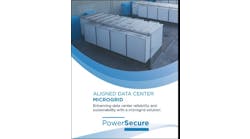Steve Hoffman, president and CEO of Hoffman Power Consulting, discusses how creating a digital twin may improve regulator, utility and local acceptance of community microgrids.
Rising interest in community microgrids
Counties and cities are increasingly recognizing the value of community microgrids to enhance community resilience and protect citizens from extreme events. Some of these communities are focusing on the competitive economic value of microgrids to retain and attract businesses, which, in turn, recognize the value of enhanced resilience for their dispersed workforce.
In island mode (isolated from the main grid), a community microgrid provides electric power to essential community services, which the community itself designates. Despite these benefits, our research found that only a handful of the 2,000 microgrids in the US are community microgrids.
Among the thousands of US cities and counties, could any not make a strong case that their residents and businesses need increased resilience in the face of extreme weather, wildfires, and cyber and physical security attacks? Despite this urgent need, progress continues to drag — and that may cost lives.
Can a digital twin help?
A potential way to accelerate this process is use of a digital twin — a computer model of a physical asset, which links the virtual world with the physical world in varying levels of complexity. Ideally, the linkage extends beyond a digital copy of a product and leads to a software representation of a process. The convergence and proliferation of IoT sensors, big data, low-cost cloud computing, artificial intelligence and machine learning, and visualization advances such as augmented reality and virtual reality are enabling digital twins to produce real-time simulations with real world data.
Can this convergence of technologies that support a digital twin help increase the reliability, productivity and performance of the electric grid? Randy Rhodes, technical executive at the Electric Power Research Institute, said, “There’s no doubt: Digital twin technology is coming to the grid.” Schneider Electric asserts that, in general, a digital twin framework can solve problems such as these:
- Transform the customer experience.
- Eliminate silos that prevent high-quality data sharing.
- Facilitate rapid creation of customized products.
- Shorten the product development life cycle.
- Increase productivity.
- Test “what-if” scenarios and incorporate feedback.
- Reduce the CapEx requirements of new or upgraded electric facilities of plant design or electric distribution upgrades.
Assuming that claims of digital twin benefits are defensible, how can a digital model streamline the acceptance of community microgrids? What barriers must a community microgrid overcome, and how can a digital twin accelerate the process?
Microgrid designers, utilities, electricity users and communities can benefit from use of a digital twin (right) of a microgrid (left). Source: Hoffman Power Consulting
Microgrid barriers and the digital twin
There are a few reasons for slow progress toward community microgrids, as well as possible solutions:
- Limited availability of capital: Creating a digital twin could allow microgrid designers to simulate the impacts of cost-cutting measures. By modeling different levels of distribution capacity with the microgrid in island or grid-connected mode, for example, designers could evaluate the trade-offs of various CapEx strategies.
- Regulatory uncertainty: The visualization capabilities of a digital twin could credibly simulate and demonstrate the impacts of selected regulatory paths.
- Microgrid as a public utility: Microgrid designers could visualize and analyze the impact of serving multiple customers, and hence help address the complexities of microgrid designation as a public utility.
- Uncertain utility support: Although concerned about reduced revenue, electric utilities also recognize the high cost of transmission and distribution upgrades. Combined with an economic analysis, a digital twin could enable the utility to explore the potential costs and benefits of a microgrid in a load pocket: Would the reduction in CapEx outweigh the loss of customer revenue?
- Perceived high technical risk: A digital model may be able to reduce technical risk by modeling “what-if” scenarios. For example, the digital twin could simulate the effects and potential risks of proven “off-the-shelf” components, compared with bespoke equipment.
- Perceived high financial risk: Financial analysis of a conventional (single-customer) microgrid is relatively straightforward. However, analyzing the financial risks and rewards of a multicustomer community microgrid is more complex. A digital twin could provide useful information to help define the level and types of financial risk involved in a community microgrid project. This is particularly true if analysts obtain real-time data to simulate community microgrid revenues under various scenarios.
Making best use of this emerging technology
Can digital twin technology facilitate and accelerate community microgrid acceptance? What are the next steps to take best advantage of this emerging technology? Hoffman Power Consulting welcomes your opinion and information on digital twin use for microgrids.
Steve Hoffman is president and CEO of Hoffman Power Consulting. Learn more in their white paper, “Six Barriers to Community Microgrids.”







